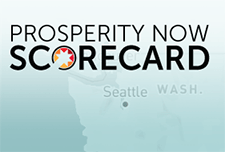Discover financial empowerment resources
Discover financial empowerment resources
The Money Matters resources are for use at home and in workshops and activities that are also free for participants. These workbooks are available in several formats and languages. Topics include: Spending Plans Banking Basics Borrowing Money Ways to Save Smart Shopping Building...

More than 44 million people in America have taken on student debt to pursue a post-secondary education. These borrowers collectively owe around $1.6 trillion in student loan debt. Borrowers exist in every community, but some are particularly vulnerable to its impact. Women hold two-thirds of all...

The Prosperity Now Scorecard is a comprehensive resource featuring data on family financial health and policy recommendations to help put all U.S. households on a path to prosperity. The Scorecard equips advocates, policymakers and practitioners with national, state, and local data to...

This report sheds light on the role employers and philanthropy can play in best promoting financial well-being for workers through the offering of Employee Financial Wellness Programs (EFWPs). Data suggests that EFWPs improve employees financial stability and help create a more productive work...

As student loan reform continues to dominate national discourse, a NEFE-funded study shows that financial education in states with state-mandated personal finance graduation requirements causes students to make better decisions about how to pay for college. It increases applications for aid,...

This is the first in a series of @ Issue Papers that looks at the participation of traditionally under-represented cohorts in postsecondary education. The purpose of this @ Issue Paper is to summarize what is currently known about the participation of low-income students in PSE, with a particular...
Canada has quietly moved from the era of the health care review to the era of the review of postsecondary education. Having digested (or set aside) the recommendations of the Romanow and Kirby commissions, federal and provincial governments have developed an appetite for proposals on how to enhance...
Financial capability is a multi-dimensional concept that encompasses a combination of knowledge, resources, access, and habits. The NFCS is designed to understand and measure a rich, connected set of perceptions, attitudes, experiences, and behaviours across a large, diverse sample in order to...
In this brief, we explore the dynamic patterns of student borrowing across sectors of higher education since 1996. In particular, we examine the role of student demographics, financial need, work behaviour, and educational costs in contributing to the trends in student borrowing. An understanding...
Reimagining financial aid to include asset accumulation for those currently disadvantaged has the potential to meet one of our most critical challenges: equipping enough students to succeed in college education to power future societal economic prosperity, at a cost individual students and our...
